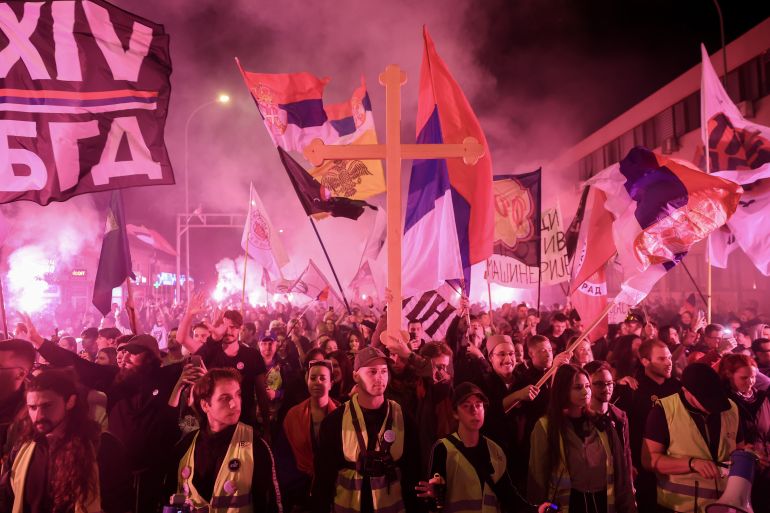Thousands march in Serbia to mark deadly train station collapse a year ago
Youth are marching from Belgrade to join a rally in the country’s north after months of sustained protests.

Published On 31 Oct 202531 Oct 2025
Save
Thousands of Serbian youth are marching across the country before a mass rally in the northern town of Novi Sad, marking the first anniversary of a train station collapse that prompted the country’s biggest antigovernment protest movement in decades.
The roof failure on November 1 last year killed 16 people, including four children, and led to ongoing calls to remove the right-wing populist President Aleksandar Vucic. Protesters have blamed deep-seated government corruption and demanded snap elections, which Vucic has ignored.
Recommended Stories
list of 4 itemsend of list
In the capital of Belgrade on Thursday, university students waved flags as they started the 90km (56-mile) march to Novi Sad, where they are expected to join tens of thousands of other protesters on Saturday.
Others have been marching for weeks, including from the southwestern town of Novi Pazar, more than 300km (185 miles) from Novi Sad, reported Al Jazeera’s Milena Veselinovic.
“The main reason we decided to do the walk is the 16 victims, and the fact that even after one year, no one has been held responsible for their deaths,” Emina Spahic, one of the Novi Pazar students, told Al Jazeera.
Enes Dzogovic, another student, said people in even “the most remote places” had aided the students with “whatever we need” along the road.
“They’re always there to help us,” he said.

Escalating protests
What started as an outcry against the train collapse has since morphed into wider discontent with Vucic’s government.
Advertisement
Prosecutors eventually charged 13 people, including a former transport minister, over the tragedy. But the charges require approval from a higher court, and no trial date has been set.
Government officials have denied accusations of corruption and inadequate oversight.
In recent months, protesters have faced an increasingly violent police response, prompting the Council of Europe and other watchdogs to express concern over authorities’ excessive use of force.
At a Pride rally in September, police wielded tear gas and stun grenades, with students accusing them of launching “brutal attacks on their own citizens”.
Nikolina Sindjelic, a student who was arrested during protests in August, said at another rally that police beat her when she was detained.
“They have hit us and they will hit us because they know it is all over [for them],” Sindjelic told the crowd.
Over the past month, about 1,000 protesters have been arrested, Al Jazeera’s Veselinovic reported.
Vucic, who has held office since 2017, has falsely claimed that foreign security services are behind antigovernment protesters, as he defended police actions.
“We are not going to allow destruction of the state institutions,” Vucic said last month. “Serbia is a strong and responsible state.”
Critics accuse Vucic of being increasingly authoritarian since coming to power, first as prime minister in 2014 and then as president since 2017. Serbians have a history of uprooting strongman leaders; they removed Slobodan Milosevic 25 years ago after bloody protests.
